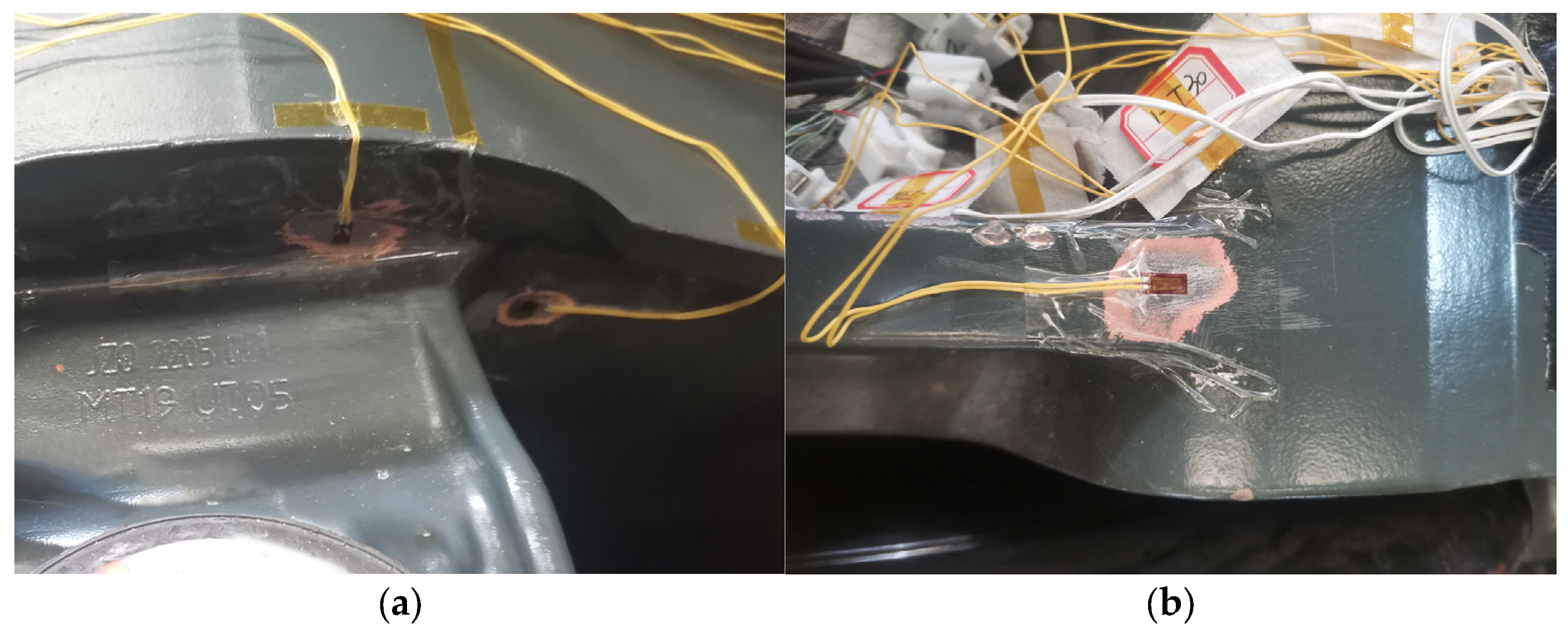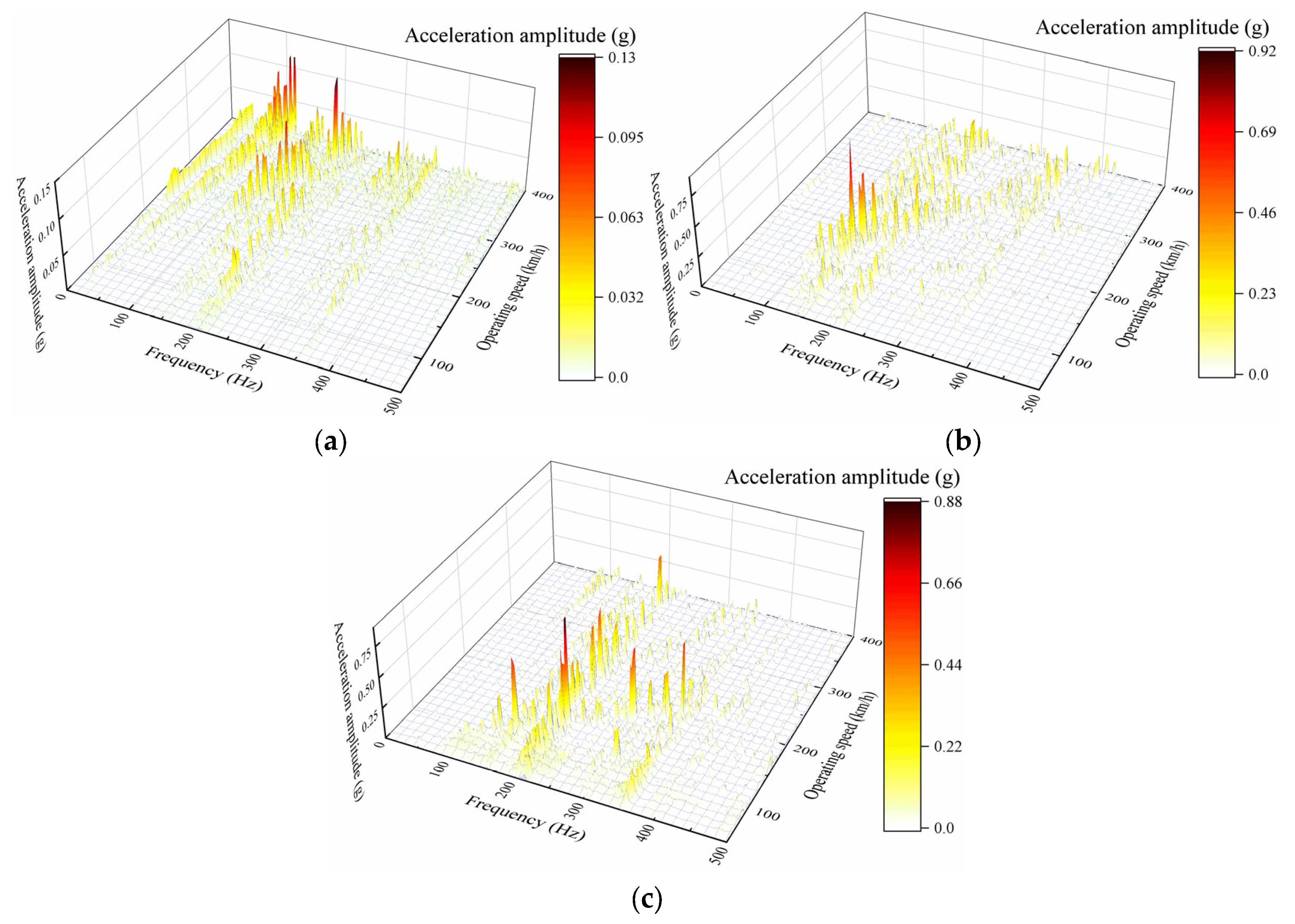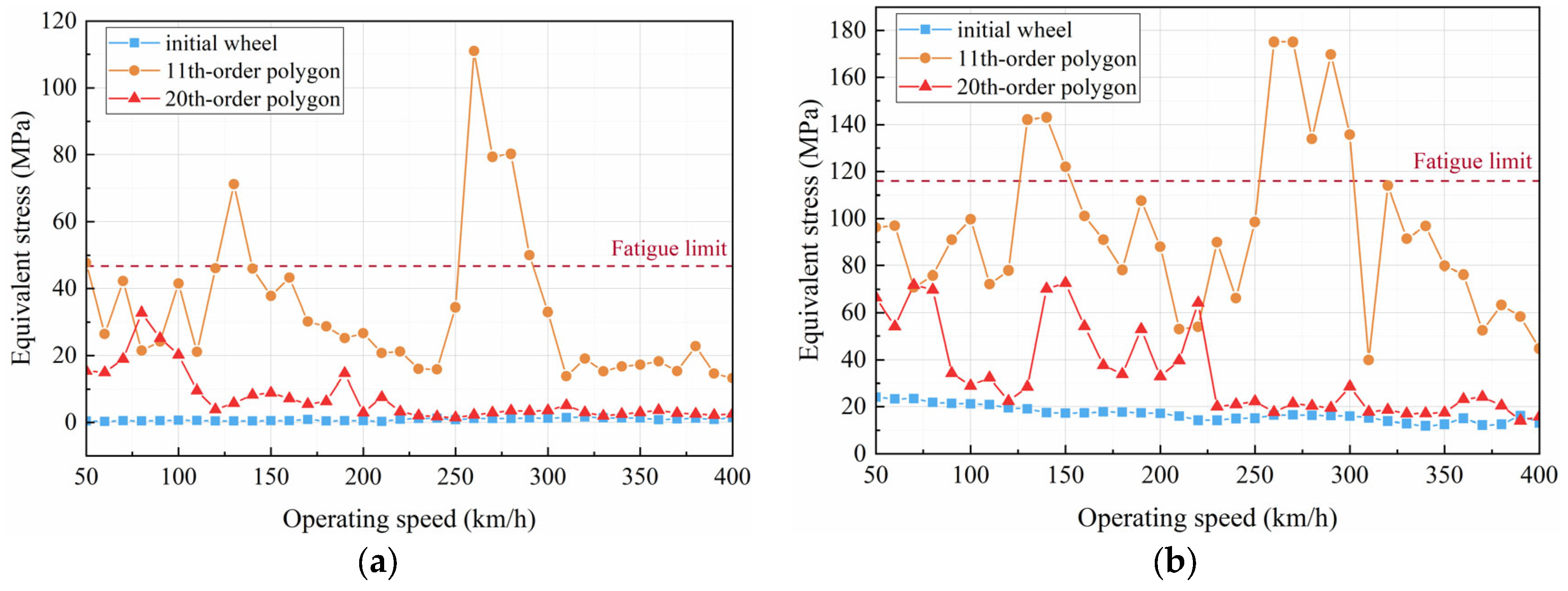Vibration Characteristics and Fatigue Performance of Bogie Frame with Inner Axle Box for High-Speed Trains
Abstract
1. Introduction
2. Test Method
3. Vibration Characteristics
3.1. Operational Modal Analysis
3.2. Vibration Transmission Characteristics
3.3. Stress Characteristics
4. Fatigue Performance Assessment
4.1. Frequency-Domain Fatigue Evaluation Method
4.2. Fatigue Analysis
5. Conclusions
Author Contributions
Funding
Data Availability Statement
Conflicts of Interest
References
- Xiu, R.; Spiryagin, M.; Wu, Q.; Yang, S.; Liu, Y. Fatigue Life Assessment Methods for Railway Vehicle Bogie Frames. Eng. Fail. Anal. 2020, 116, 104725. [Google Scholar] [CrossRef]
- Wang, S.; Wu, P.; Song, Y.; Liu, C.; Ye, Y.; Li, F. Vibration Environment Spectrum Investigation of Metro Bogie Frame End. Eng. Fail. Anal. 2024, 157, 107865. [Google Scholar] [CrossRef]
- Karpenko, M.; Ževžikov, P.; Stosiak, M.; Skačkauskas, P.; Borucka, A.; Delembovskyi, M. Vibration Research on Centrifugal Loop Dryer Machines Used in Plastic Recycling Processes. Machines 2024, 12, 29. [Google Scholar] [CrossRef]
- Karpenko, M.; Prentkovskis, O.; Skačkauskas, P. Analysing the Impact of Electric Kick-Scooters on Drivers: Vibration and Frequency Transmission during the Ride on Different Types of Urban Pavements. Eksploat. Niezawodn-Maint. Reliab. 2025, 27, 1–14. [Google Scholar] [CrossRef]
- Wang, B.J.; Xie, S.Q.; Li, Q.; Ren, Z.S. Fatigue Damage Prediction of Metro Bogie Frame Based on Measured Loads. Int. J. Fatigue 2022, 154, 106532. [Google Scholar] [CrossRef]
- Lu, Y.; Zheng, H.; Zeng, J.; Chen, T.; Wu, P. Fatigue Life Reliability Evaluation in a High-Speed Train Bogie Frame Using Accelerated Life and Numerical Test. Reliab. Eng. Syst. Saf. 2019, 188, 221–232. [Google Scholar] [CrossRef]
- Seurat, C. Carbon Fibre Based Bogie: Challenging applications in composites: Railway compliant, recycled carbon fibre based bogie. Sampe J. 2021, 57, 6. [Google Scholar]
- Alessio, C.; Meli, E.; Rindi, A. A Strategy for Lightweight Designing of a Railway Vehicle Car Body Including Composite Material and Dynamic Structural Optimization. Railw. Eng. Sci. 2023, 31, 340–350. [Google Scholar] [CrossRef]
- Ma, Q.; Qin, X.; Gan, X.; Wang, Y. Study on Structural Optimization of Braid-and-Lay Integrated Carbon Fiber Reinforced Polymer for Metro Bogie. Polym. Compos. 2023, 44, 6419–6439. [Google Scholar] [CrossRef]
- Han, Y.; Ruichen, W.; Paul, A.; David, C.; Wenjie, F. Analysis of Failure Mechanisms for CFRP Laminated Composite Bogie Frames of the next Generation High-Speed Trains under Service Environment. Eng. Fail. Anal. 2025, 178, 109701. [Google Scholar] [CrossRef]
- Ding, L.; He, Z.; Chen, B. Strength Assessment and Lightweight Optimization Design of a Bogie Frame Based on the Structural Stress Method. Int. J. Struct. Integr. 2024, 16, 159–186. [Google Scholar] [CrossRef]
- Cascino, A.; Meli, E.; Rindi, A. A New Strategy for Railway Bogie Frame Designing Combining Structural–Topological Optimization and Sensitivity Analysis. Vehicles 2024, 6, 651–665. [Google Scholar] [CrossRef]
- Zou, H.; Wu, Q.; Zou, X. Research on Optimization Design of Suspension Parameters of Railway Vehicle Bogies Based on Surrogate Model. Multimed. Tools Appl. 2025, 84, 35091–35109. [Google Scholar] [CrossRef]
- Xiao, Q.; Zhang, M.; Chen, D.; Wang, X.; Lei, C. The Operational Performance and Fatigue Life Analysis of Internal Suspension Bogie. J. Braz. Soc. Mech. Sci. Eng. 2025, 47, 634. [Google Scholar] [CrossRef]
- Guo, L.; Li, G.; Chen, C.; Zhang, Y.; Zhang, H.; Gong, D. Vibration Fatigue Characteristics of a High-Speed Train Bogie and Traction Motor Based on Field Measurement and Spectrum Synthesis. Machines 2025, 13, 613. [Google Scholar] [CrossRef]
- Wu, X.; Zhang, Z.; Cai, W.; Yang, N.; Jin, X.; Wang, P.; Wen, Z.; Chi, M.; Liang, S.; Huang, Y. A Critical Review of Wheel/Rail High Frequency Vibration-Induced Vibration Fatigue of Railway Bogie in China. Railw. Sci. 2024, 3, 177–215. [Google Scholar] [CrossRef]
- Wei, L.; Sun, Y.; Zeng, J.; Qu, S. Experimental and Numerical Investigation of Fatigue Failure for Metro Bogie Cowcatchers Due to Modal Vibration and Stress Induced by Rail Corrugation. Eng. Fail. Anal. 2022, 142, 106810. [Google Scholar] [CrossRef]
- Xiao, X.; Wang, Q.; Zhang, Y.; Han, J.; Jin, X. The Dynamic Characteristics of the Hydraulic Damper on the High-Frequency Vibration Transmission of the Bogie. Int. J. Rail Transp. 2025, 2, 1–20. [Google Scholar] [CrossRef]
- Peng, B.; Wu, X.; Zhang, Z.; Yang, N.; Hu, F.; Wang, P.; Mi, C.; Chi, M.; Wu, S. Determination of Wheel Polygonal Wear Limit and Fatigue Life of Railway Bogie Frames Considering Wheel/Rail Excitation. Eng. Fail. Anal. 2025, 169, 109220. [Google Scholar] [CrossRef]
- Zhang, L.; Wang, Z.; Wang, Q.; Mo, J.; Feng, J.; Wang, K. The Effect of Wheel Polygonal Wear on Temperature and Vibration Characteristics of a High-Speed Train Braking System. Mech. Syst. Signal Process. 2023, 186, 109864. [Google Scholar] [CrossRef]
- Shi, Y.; Mao, Q.; Wang, Q.; Dai, H.; Peng, X.; Dong, C. Research on Wheel Polygonal Wear Based on the Vehicle–Track Coupling Vibration of Metro. Machines 2025, 13, 587. [Google Scholar] [CrossRef]
- Hou, M.; Chen, B.; Cheng, D. Study on the Evolution of Wheel Wear and Its Impact on Vehicle Dynamics of High-Speed Trains. Coatings 2022, 12, 1333. [Google Scholar] [CrossRef]
- Nieminen, V.; Tuohineva, A.; Autio, M. Wheel Load Reconstruction Using Strain Gauge Measurements on the Bogie Frame for Strain Prediction and Fatigue Assessment. Int. J. Fatigue 2023, 170, 107533. [Google Scholar] [CrossRef]
- Seo, J.-W.; Hur, H.-M.; Kwon, S.-J.; Moon, K.-H. Evaluation of Fatigue Crack Growth Behavior of Bogie Frames under Operating Load. J. Mech. Sci. Technol. 2024, 38, 2919–2929. [Google Scholar] [CrossRef]
- EN 13749; Railway Applications—Wheelsets and Bogies—Method of Specifying the Structural Requirements of Bogie Frames. CEN: Brussels, Belgium, 2011.
- Cai, W.; Wu, X.; Chi, M.; Huang, H.-Z. High-Order Wheel Polygonal Wear Growth and Mitigation: A Parametric Study. Mech. Syst. Signal Process. 2023, 186, 109917. [Google Scholar] [CrossRef]
- Dong, Q.; Wang, Y.; Zhang, J.; Liu, B.; Fan, L.; Hou, M. Impact of Wheel Tread Damage-Induced Vibrational Loads on the Service Life of Rail Bogie Frames. Eng. Fail. Anal. 2025, 176, 109630. [Google Scholar] [CrossRef]
- IEC 61373; International Electro Technical Commission Technical Committee 9; Railway Applications-Rolling Stock Equipment Shock and Vibration Test. Standards Press of International Electro Technical Commission: Geneva, Switzerland, 2010.
- Šonc, J.; Zaletelj, K.; Slavič, J. Application of Thermoelasticity in the Frequency-Domain Multiaxial Vibration-Fatigue Criterion. Mech. Syst. Signal Process. 2025, 224, 112002. [Google Scholar] [CrossRef]
- Dirlik, T. Application of Computers in Fatigue Analysis; Warwick University: Coventry, UK, 1985. [Google Scholar]
- Wu, Y.; Ren, Z. Fatigue Damage Assessment of a Metro Vehicle Bogie Frame Based on Measured Field Load. Machines 2025, 13, 306. [Google Scholar] [CrossRef]
- IIW-1823–2008; Joint Working Group; XIII-1965–03/XV-1127–03 IIW-1823–2008 Document Recommendations for Fatigue Design of Welded Joints and Components. International Institute of Welding: Cambridge, UK, 2003.


















| Mode Frequency of Bogie Frame (Hz) | Operating Speed (km/h) | ||||
|---|---|---|---|---|---|
| 11th Order | 1/2 of 11th Order | 20th Order | 1/2 of 20th Order | 1/3 of 20th Order | |
| 162 | 150 | 300 | 80 | 170 | 250 |
| 201 | 190 | 380 | 110 | 220 | 330 |
| 345 | 320 | 180 | 360 | ||
| 430 | 400 | 220 | |||
| Measurement Position | Equivalent Stress Amplitude (MPa) | |||||
|---|---|---|---|---|---|---|
| Initial Wheel | 11th-Order Polygon | 20th-Order Polygon | ||||
| 300 km/h | 400 km/h | 300 km/h | 400 km/h | 300 km/h | 400 km/h | |
| Base material of frame | 15.99 | 13.17 | 135.73 | 44.71 | 28.64 | 15.77 |
| Weld seam of draw bar seat | 1.26 | 1.48 | 29.01 | 13.19 | 3.65 | 2.61 |
| Weld seam of brake mounting seat | 1.56 | 1.00 | 2.66 | 1.68 | 3.94 | 4.22 |
| Weld seam on traction motor seat | 1.26 | 1.48 | 32.97 | 13.18 | 3.65 | 2.61 |
| Weld seam of gearbox seat | 2.42 | 1.64 | 18.53 | 5.42 | 6.65 | 8.78 |
| Weld seam of lateral damper seat | 2.90 | 2.84 | 9.05 | 7.54 | 11.69 | 13.77 |
Disclaimer/Publisher’s Note: The statements, opinions and data contained in all publications are solely those of the individual author(s) and contributor(s) and not of MDPI and/or the editor(s). MDPI and/or the editor(s) disclaim responsibility for any injury to people or property resulting from any ideas, methods, instructions or products referred to in the content. |
© 2025 by the authors. Licensee MDPI, Basel, Switzerland. This article is an open access article distributed under the terms and conditions of the Creative Commons Attribution (CC BY) license (https://creativecommons.org/licenses/by/4.0/).
Share and Cite
Guo, T.; Chen, B.; Wang, Y.; Cai, G.; Hou, M.; Dong, Q. Vibration Characteristics and Fatigue Performance of Bogie Frame with Inner Axle Box for High-Speed Trains. Machines 2025, 13, 1056. https://doi.org/10.3390/machines13111056
Guo T, Chen B, Wang Y, Cai G, Hou M, Dong Q. Vibration Characteristics and Fatigue Performance of Bogie Frame with Inner Axle Box for High-Speed Trains. Machines. 2025; 13(11):1056. https://doi.org/10.3390/machines13111056
Chicago/Turabian StyleGuo, Tao, Bingzhi Chen, Yuedong Wang, Guojie Cai, Maorui Hou, and Qi Dong. 2025. "Vibration Characteristics and Fatigue Performance of Bogie Frame with Inner Axle Box for High-Speed Trains" Machines 13, no. 11: 1056. https://doi.org/10.3390/machines13111056
APA StyleGuo, T., Chen, B., Wang, Y., Cai, G., Hou, M., & Dong, Q. (2025). Vibration Characteristics and Fatigue Performance of Bogie Frame with Inner Axle Box for High-Speed Trains. Machines, 13(11), 1056. https://doi.org/10.3390/machines13111056







